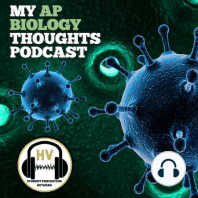7 min listen
Osmotic Pressure of Animal Cells
ratings:
Length:
1 minute
Released:
May 14, 2021
Format:
Podcast episode
Description
My AP Biology Thoughts Unit 2 Cell Structure and FunctionWelcome to My AP Biology Thoughts podcast, my name is Victoria and I am your host for episode #61 called Unit 2 Cell Structure and Function: Osmotic Pressure of Animal Cells. Today we will be discussing _the osmotic pressure of animal cells.Segment 1: Introduction to Osmotic Pressure What is osmosis? The movement of a solvent/water through a semipermeable membrane from a low concentration or high water potential, where there is less solute to a higher concentration or low water potential, and it’s goal is to reach equilibrium of equal concentration of solute on the inside and out of the membrane/cellan example of passive transports as it does not require energy What is osmotic pressure?Osmosis creates pressure The pressure that must be applied to the solution side to stop fluid movement when a semipermeable membrane separates a solution from pure water.the pressure that would be required to stop water from diffusing through a barrier by osmosis. In other words, it refers to how hard the water would “push” to get through the barrier in order to diffuse to the other side.Determined by solute concentration, water will “try harder” to diffuse into an area with a high concentration of a solute, such as a salt, than into an area with a low concentration.Segment 2: More About Osmotic Pressure of Animal CellsWater moves to hypertonic areasIt can threaten the health of cells and organisms when there is too much or too little water in the extracellular environment compared to the inside of the cell.Animal cells lack a cell wall, and use active transport systems (especially the NA+ K+ ATPase that moves 3 NA+ out for each 2 K+ that move in) to move ions outside the cell reducing the osmotic pressure. Most protozoa use a special contractile mechanism. Water collects in a vesicle, and microfilaments force a contraction that squeezes water back outside the cell. This pump mechanism protects the cell from osmotic pressure Segment 3: Connection to the Course How does the osmotic pressure of animals connect back to cell structure and function?Without osmotic pressure the animal cells would not be able to move solvent/water through a semipermeable membrane from a low concentration to high concentration, and not reach equilibrium of equal concentration of solute on the inside and out of the membrane/cellThis will collapse its structure and both will then lead the cell to death unable to perform its necessary functions It is vital as the cell’s membrane is selective toward many of the solutes found in living organismsIt determines the state/survival of the cell as well, like when it is placed in a hypotonic, isotonic, or hypertonic solutionsThank you for listening to this episode of My AP Biology Thoughts. For more student-ran podcasts and digital content, make sure that you visit www.hvspn.com. See you next time!Music Credits:“Ice Flow” Kevin MacLeod...
Released:
May 14, 2021
Format:
Podcast episode
Titles in the series (100)
Innate, Learned and Complex Behaviors by My AP Biology Thoughts
